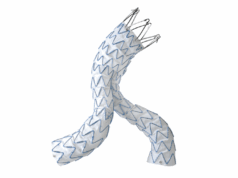
Terumo Aortic has been granted Food and Drug Administration (FDA) approval for the Treo abdominal aortic stent-graft system to be sold in the U.S.
The Treo, used in the treatment of patients with abdominal aortic aneurysms (AAA), is the only device commercially available for endovascular aneurysm repair (EVAR) with dual proximal fixation and lock stent technology offering physicians the next advancement in endovascular device solutions, according to Terumo Aortic.
It is a three-piece design featuring in situ limb adjustability and provides a wide range of aortic device configurations to specifically address the anatomy of each individual patient. Treo is designed for accurate, controlled and safe deployment; the exclusive proximal clasping mechanism and a unique leave-behind sheath simplify the procedure as highlighted in recent clinical studies.
Scott Rush, Terumo Aortic’s vice president of research and development said: “We set out to provide a AAA system with the most comprehensive set of benefits available and believe that we have an implant and delivery system that is unmatched in terms of design features. The tri-modular design and in situ sizing of Treo allow physicians to deliver a tailored solution by selecting components precisely sized and joined for each patient’s anatomy.”
“Stent migration and endoleaks are major concerns in EVAR,” said Matthew Eagleton, MD, of Massachusetts General Hospital, Boston, the national principal investigator of the IDE Study. “The Treo stent-graft offers both suprarenal and infrarenal fixation, distributing the stent-graft fixation in two different anatomical levels which may work to reduce potential migration. I have been very impressed with the results of the trial, particularly in the sac shrinkage data. I expect this to lower re-intervention rates in my practice.”
The Treo device received CE Mark approval in 2015.
Thoraflex Hybrid moves forward

Meanwhile, toward the end of April Terumo Aortic announced that the FDA had granted breakthrough device designation for its Thoraflex Hybrid stented device for complex aortic arch repair.
The purpose of the FDA’s breakthrough device designation program is to fast-track the regulatory review process for certain medical technologies and device-led combination products that satisfy certain criteria; these include providing a more effective treatment or diagnosis of life-threatening or irreversibly debilitating diseases or conditions.
The aim of the program is to provide patients and healthcare professionals with timely access to important breakthrough medical devices by accelerating their development, assessment and review, while preserving the statutory standards for premarket approval and 510(k) clearance.
The Thoraflex Hybrid is a single-use medical device combining a gelatin-sealed woven polyester graft with a Nitinol self-expanding stent graft and is indicated for the surgical repair or replacement of damaged or diseased vessels of the aortic arch and descending aorta.
Advanced age, smoking or genetic inheritance may result in the aortic wall weakening and bulging which can lead to a ruptured thoracic aortic aneurysm (TAA). TAA rupture remains a significantly fatal condition with most patients only surviving for six hours if there is no surgical intervention.
Another condition is aortic dissection where a tear develops in the vessel wall; should either occur the artery may rupture and only one in five patients survives.
Joseph Coselli, MD, professor, vice chair and chief in the division of cardiothoracic surgery at Baylor College of Medicine in Houston, the principal investigator for Thoraflex Hybrid commented: “This breakthrough designation from the FDA will allow US physicians to treat patients who may be at great risk of rupture with a device that brings the primary benefit of requiring a single stage procedure instead of the conventional treatment involving two procedures thus lowering the risk of patient mortality and potentially reducing overall operating time and hospital costs.”
The Thoraflex Hybrid device became the world’s first multi-branched “frozen elephant trunk” prosthesis when it received CE Mark approval in 2012.










